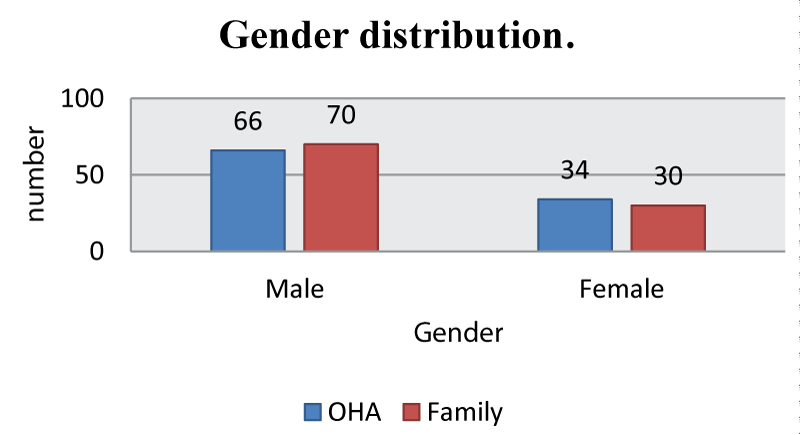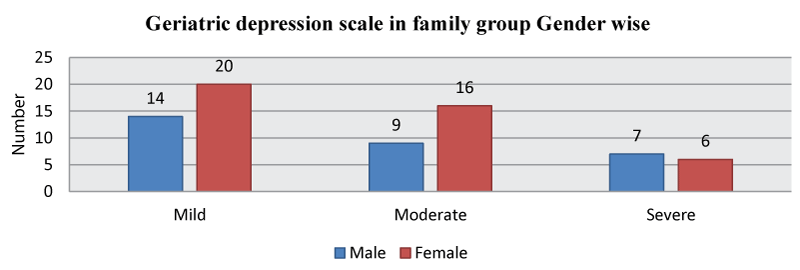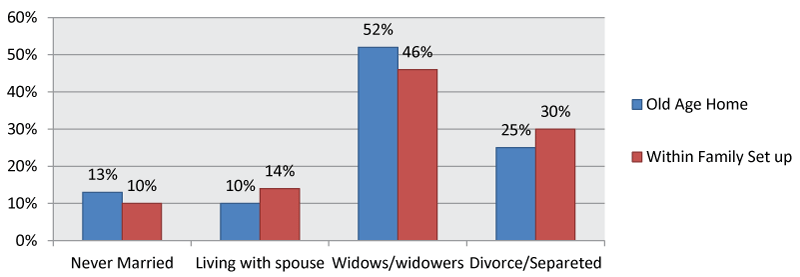Journal of Addiction Medicine and Therapeutic Science
Assessment of depression among elderly living in old age homes and within family set up in Bareilly city: A cross-sectional study
Nandita Gautam1*, Shivalingesh KK2, Anushtha Kushwaha1, Lubna Shoaib3 and Vertika Mahar4
2Professor & Head, Department of Public Health Dentistry Institute of Dental Sciences, Bareilly, India
3Department of Periodontology, Institute of Dental Sciences, Bareilly, India
4Department of Conservative Dentistry & Endodontics, Institute of Dental Sciences, Bareilly, India
Cite this as
Gautam N, Shivalingesh KK, Kushwaha A, Shoaib L, Mahar V (2022) Assessment of depression among elderly living in old age homes and within family set up in Bareilly city: A cross-sectional study. J Addict Med Ther Sci 8(1): 006-009. DOI: 10.17352/2455-3484.000053Copyright
© 2022 Gautam N, et al. This is an open-access article distributed under the terms of the Creative Commons Attribution License, which permits unrestricted use, distribution, and reproduction in any medium, provided the original author and source are credited.Introduction: Aging is a natural process but at the same time, the aging population has substantially increased. Socially this stage is considered the total of one lived experience.
Materials and methods: The sample size has been 200 which is 100 in each group. Individuals beyond 60 years of age and who will be able to cooperate with the study were included in the study. Geriatric Depression Scale (GDS) was used to record depression among the same subject. The data were entered into an excel sheet and transferred to SPSS V. 21. for statistical analysis and Chi-square and ANOVA tests were done.
Results: The prevalence of depression in elderly individuals living in family settings was 22% mild, 14% moderate, and 10% severe, whereas, in old age homes, the prevalence was 36% mild, 26% moderate, and 8% severe. On comparison of depression according to marital status among the elderly within the family set up and old age home reported a statistically significant difference between the 2 groups (p < 0.001).
Conclusions: We found from this study that the overall prevalence of depression was higher in elderly people residing in old age homes. It is more common in older women than in men.
Introduction
‘Old age is called ‘dark” not because the light fails to shine, but because people refuse to see It’- Quoted by James A Michener.
Aging is a natural process but at the same time, the aging population has substantially increased. Socially this stage is considered the sum total of one lived experience. Hence, the society offers a space of respect to the old. In such a society the aged are the repositories, transmitters, and soul authorities of wisdom and knowledge. All of these provide a “golden age” concept to this stage [1]. A joint report by the United Nations Population Fund and Help age International in 2012 said India has around 100 million older adults and the number is expected to increase to 323 million by 2050, constituting 20% of the total population [2].
Reduced physical capacity, deteriorating mental ability, gradual abandonment of role-playing in socio-economic activities, and a transition in economic status from financial stability to economic dependency on others for assistance and care are all symptoms of old age. Aging is an unavoidable growth process that brings with it a slew of social, psychological, hormonal, and physical changes. These changes have an impact on the elderly’s quality of life [3].
As the elderly population in India is growing phenomenally in number, the size of the family is reducing at the same time, especially in urban areas [4]. Urbanization, modernization, and globalization have led to changes in economic structure and erosion and weakening of social values. In the changing economic and social milieu, the younger generation is searching for new identities encompassing economic independence and redefined social roles within as well as outside the family [5].
The joint family system has been prevalent for a long time in India and the children, especially the sons, cared for their aged parents. Nevertheless, in recent times, there has been a change in the family structure and the traditional joint family system is on the decline. With the increase in nuclear families, Indians are moving out of the traditional values. This is leading to changes in the physical and mental health of the old age population and the emergence of old age homes for a living. In old age homes they feel lonely but at the same time, feel a sense of independence [4].
On the other hand, some are forced to move to an old age home because they had experienced a lack of emotional support, verbal and at times physical abuse, neglect, and disrespect from their children. In spite of all the discomfort and inconvenience, they seem to prefer to live in the comfort of their home with their children and grandchildren [5]. Oral health is an integral part of general health and can influence the overall wellbeing of an individual [6]. Other than oral health, mental health, and emotional well-being are as important in older age as at any other time of life. As the age advances beyond 60 years, the people are subjected to emotional turmoil due to social maladjustment as a result of which they undergo a phase of depressive illness, which can extend to become a multisystem disorder [7].
The aim of the study is to assess depression among the geriatric population of Bareilly city living in old age homes and the family setup. Keeping these points in mind, an attempt was made to assess the mental health status of elderly people living in old age homes and family setups.
Materials and methods
The cross-sectional study was conducted (December 2019 – November 2020) in the residential societies (Suresh Sharma Nagar, Green Park, and Sun City) and old age homes (Vradhjan Avas Grah) of Bareilly city. For the current study estimated sample size was rounded to 200 (using G Power V 3.1 Software) and divided into two groups as mentioned above i.e. 100 in each group. Geriatric population living in old age homes (Group-1) and in a family set up (Group-2) in Bareilly city. The objective of the study was to estimate the depression among the geriatric population living in old age homes and within the family setup.
Ethical clearance was obtained from the Institutional Review Board (IRB) of the Institute of Dental Sciences, Bareilly, India. The sample size has been scientifically estimated using G Power V 3.1 Software which yielded a minimum sample size of 200 which is 100 in each group. Subjects who are willing to give their consent, individuals beyond 60 years of age, and who will be able to cooperate with the study were included in the study. While Subjects with cognitive impairment and reported psychological problems were excluded from the study. A modified case history proforma consisting of demographic details, and information related to psychological and systemic health will be used to collect data from the subjects Geriatric Depression Scale (GDS) was used to record depression among the same subject. The GDS Form is a brief, 30-item questionnaire in which participants are asked to respond by answering yes or no about how they felt over the past week. A Short Form GDS consisting of 15 questions was developed in 1986. Questions from the Long Form GDS which had the highest correlation with depressive symptoms in validation studies were selected for the short version. Of the 15 items, 10 indicated the presence of depression when answered positively, while the rest (question numbers 1, 5, 7, 11, 13) indicated depression when answered negatively. Scores of 0-4 are considered normal, depending on age, education, and complaints; 5-8 indicate mild depression; 9-11 indicate moderate depression and 12-15 indicate severe depression.
The data were entered into an excel sheet and transferred to SPSS V. 21. for statistical analysis and Chi-square and ANOVA tests were done.
Results
The study was conducted A cross-sectional study (December 2019 – November 2020) in the residential societies (Suresh Sharma Nagar, Green Park, and Sun City) and old age homes (Vradhjan Avas Grah) of Bareilly city.
The participants were above 60 years of age. In the 60-69-year-old age range, 31% of the subjects came from a family setting, and 43% were seen in an old age home, which was the highest percentage among the study participants. In the 70-79-year-old age range, 32 percent were detected in both categories. Old age homes accounted for 25% of the population over the age of 80, while residential society accounted for 37%. The mean age (mean SD) was determined to be 73.85 8.44 (residential society group) and 76.84 8.90 (old age home group). In a comparison of age among the study subjects, there was a statistically significant difference between the 2 groups (p < 0.001) as shown in Table 1, Graph 1.
From Graph 1 it was discovered that out of 200 elderly people, 100 (50%) were men and 100 (50%) were women. In the group living with family members, there were 66 men and 34, whereas, in the old age homes, there were 30 men and 70 women. There was no statistically significant difference between the two groups when the gender distribution of the study individuals was compared.
The prevalence of depression in elderly individuals living in family settings was 22% mild, 14% moderate, and 10% severe, whereas, in old age homes, the prevalence was 36% mild, 26% moderate, and 8% severe, according to the Geriatric Depression Scale. In comparison in both the groups, there was no statistically significant difference found as shown Graph in 2.
According to Graph 3, females (28 percent) were more affected than males when it came to depression in the general population (14 percent). Females living in old age homes claimed 16 percent mild, 10% moderate, and 2% severe depression, while older females living in family settings revealed 20 percent light, 16 percent moderate, and 6 percent severe depression, as shown in Graph 4. There was no statistically significant difference between the two groups when compared.
Depression is common in late life, affecting nearly 5 million of the 31 million Americans aged 65 and older with clinically significant depressive symptoms reaching 13% in older adults aged 80 and older (Blazer, 2009). Major depression is reported in 8-16% of community-dwelling older adults, 5-10% of older medical outpatients seeing a primary care provider, and 10-12% of medical-surgical hospitalized older adults with 23% more experiencing significant depressive symptoms (Blazer, 2009). Recognition in long-term care facilities is poor and not consistent among studies (Blazer, 2009).
According to Graph 5, the percentage of older adults who were depressed was higher in widows/widowers (52 percent in old age homes and 46 percent in family settings) than those in people living with spouses (10 percent in old age homes and 14 percent in family settings) and never marrieds (10 percent in old age homes and 14 percent in family settings). On comparison of depression according to marital status among the elderly within the family set up and old age home reported a statistically significant difference between the 2 groups (p < 0.001).
Discussion
Around the planet, a demographic revolution is taking place. The population of adults aged 65 and over is growing at a greater rate than any other age group. The number of old persons has increased as a result of advancements in both social living conditions and medical care. There are around 600 million people aged 60 and over, with this figure anticipated to treble by 2025. As a result, health and social policymakers will face huge challenges, particularly because illness patterns will change at the same time. Depression in old age is a global public health problem that causes morbidity and impairment. Per the World Health Organization, depression is a common mental disease defined by melancholy, a loss of interest or pleasure, feelings of guilt or poor self-worth, interrupted sleep or appetite, fatigue, and decreased concentration.
Despite having the world’s second-largest population of senior citizens aged 60 and up, geriatric depression is yet to be acknowledged as a public health problem in India [8]. Out of 200 old people in the study, 100 (50 percent) were men and 100 (50 percent) were women. The participants were above 60 years old. In the 60-69-year-old age range, 31 percent of the subjects originated from a family setting, and 43 percent were seen in old age homes, which was the highest percentage among the study participants. In the 70-79-year-old age range, 32 percent were detected in both categories.
Old age homes accounted for 25% of those aged 80 and older, while family residences accounted for 37%. These findings are in agreement with those of a study performed by Sujatha KB, et al. [6], which found that 83 percent of those aged 65 to 70 years old and 17 percent of those aged 71 to 74 years old. In the residential society category, there were 66 men and 34 women, whereas, in the old age homes, there were 30 men and 70 women. These findings contrast with those of Sujatha KB, et al. [6], who found that 65 percent of the participants were men and 35 percent were women in their research.
In this research, the prevalence of depression in elderly people living in old age homes and families was 70 percent and 44 percent, respectively. In a study performed in a rural area of West Bengal in 1997, Nandi PS, et al. [9], discovered a prevalence of 55.2 percent in a population of more than 60 years. Depression was shown to be prevalent in another study performed in Udupi, Karnataka, with a frequency of 48 percent, which is similar to the current findings [10]. In a study performed among inmates of an old age home in Kottayam Kerela, Arun R, et al. [11], discovered a prevalence of 44.5 percent. However, Barua and Kar [12], identified a 21.7 percent prevalence of depressive illness in older individuals in 2010, 22.0 percent by Nandi DN, et al. [13], in Bengal, and 13.5 percent by Tiwari SC [14]. In this study, depression was shown to be more prevalent in females (42 percent in old age homes and 28 percent in the family group) than in males (30 percent in old age home prisoners and 13 percent in the family group). Sati P. Sinha [15] found similar findings in her study.
In this study, we discovered that widowed and divorced/separated older persons (42-46 percent) were more likely to be depressed than older adults who had never married. Sati P. Sinha [15] discovered similar results. According to George (1996), increased depressed symptom levels are linked to rising age, decreased socioeconomic status, and diminished quantity and quality of social relationships. Loss of significant relationships might leave you feeling empty and depressed [16]. Low socioeconomic position, external locus of control, being female, and being unmarried are all risk factors for late-life depression, according to Baldwin, et al. (2002). The death of a significant partner, such as a spouse, family member, or close friend, is linked to a higher incidence of depression [17].
Conclusions
We found from this study that the overall prevalence of depression was higher in elderly people residing in old-age homes. It is more common in older women than in men. Age, gender, divorced or separated status, and widow or widower status were all significant factors of depression in this study. Addressing some of these concerns may help to improve the quality of life of older people while also reducing the burden on their families, society, and country.
- Panday R, Kiran M, Srivastava P, Srivastava P, Kumar S. A study on quality of life between elderly people living in old age home and within family set up. Open Journal of Psychiatry & Allied Sciences. 2015; 6(2): 127-131.
- Govil P, Gupta S. Domestic Violence against Elderly People: A Case Study of India. Scientific Research Publishing 2016; 5(5):110-121.
- Singh J. Comparative study of quality of life inaged persons. Indian J of Applied Research. 2014; 4(9):1-3.
- Menezes S, Thomas TM. Status of elderly and emergence of old age homes in India. International Journal of Social Sciences and Management. 2018; 4(1): 1-4.
- Dubey A, Bhasin S, Gupta N, Sharma N. A study of Elderly Living in old age home and within family set-up in Jammu. Journal of Studies on Home and Community Science. 2011; 5(2):93-98.
- Sujhata BK, Gomez SSM, Mathew SN, Suresh J. Oral Health Problems among Geriatric Population and its Implication on General Health: A Cross-sectional survey. Journal of Dental Research and Review. 2017; 4(1):13-16.
- Karthik C, Vishwantha PG, Shobha, Ranganath TS, Sushmitha P. A study to estimate the prevalence of depression among the inmates of select old age homes in Banglore city, India. International Journal of Community Medicine and Public Health. 2016; 3(7):1803-1806.
- Rangaswamy SM. Geneva, Switzerland: The World Health Organization; 2001. World Health Report on Mental Health: New understanding New Hope. Indian J Psychiatry. 2001; 43(1): 1–4.
- Nandi PS, Banerjee G, Mukherjee SP, Nandi S, Nandi DN. A study of psychiatric morbidity of the elderly population of a rural community of West Bengal. Indian journal of psychiatry. 1997; 39:122-129.
- Lena A, Ashok K, Padma M, Kamath V, Kamath A. Health and social problems of the elderly: a cross-sectional study in udupi taluk, karnataka. Indian J Community Med. 2009 Apr;34(2):131-4. doi: 10.4103/0970-0218.51236. PMID: 19966960; PMCID: PMC2781120.
- Arun R, Kutty VR, Ravindran S. Prevalence of and correlates of depressive symptoms among inmates of old age home in Kottayam, Kerela, India.
- Barua A, Ghosh MK, Kar N, Basilio MA. Prevalence of depressive disorders in the elderly. Ann Saudi Med. 2011 Nov-Dec;31(6):620-4. doi: 10.4103/0256-4947.87100. PMID: 22048509; PMCID: PMC3221135.
- Nandi DN, Ajmany S, Ganguly H, Banerjee G, Boral GC, Ghosh A, et al. The incidence of mental disorders in 1 year in rural community in west Bengal. Indian journal of psychiatry. 1976; 18: 79-87.
- Tiwari SC. Geriatric psychiatric mobidity in rural northern India: Implication for the future. Int Psychogeriatric. 2000; 12(1): 35-48.
- Sinha SP, Shrivastava SR, Ramasamy J. Depression in an older adult rural population in India. MEDICC Rev. 2013 Oct;15(4):41-4. doi: 10.37757/MR2013V15.N4.10. PMID: 24253350.
- George L.K. Social factors and illness. In R.H. Binstock and L.K. George (Eds) Handbook of aging and social sciences, 4th edition, San Diego, CA: Academic press, 1996; 229-253.
- Baldwin R, Chiu E, Katona C, Graham N. Guidelines on depression in older people: Practicing the evidence. London: Martin Dunitz Ltd. 2002.
Article Alerts
Subscribe to our articles alerts and stay tuned.
 This work is licensed under a Creative Commons Attribution 4.0 International License.
This work is licensed under a Creative Commons Attribution 4.0 International License.






 Save to Mendeley
Save to Mendeley
